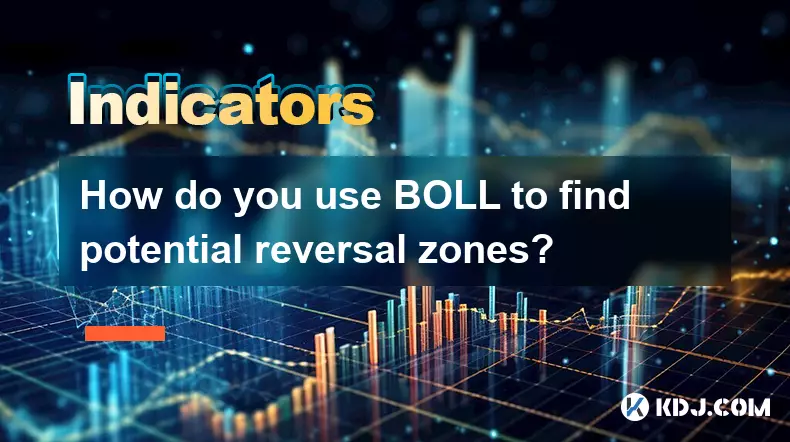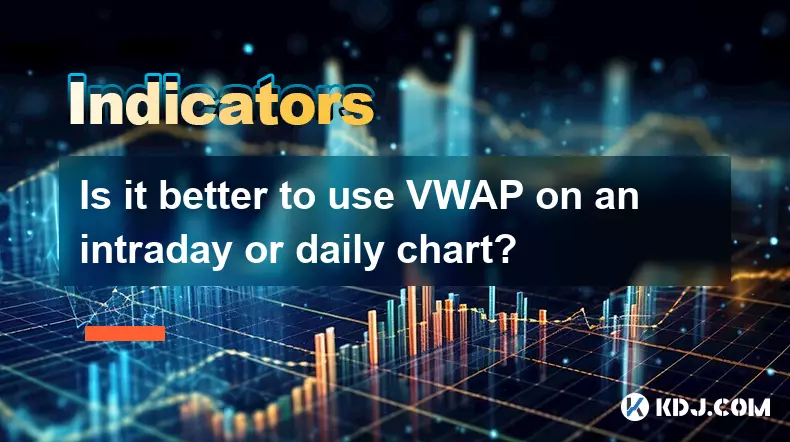-
 bitcoin
bitcoin $110918.433029 USD
-1.69% -
 ethereum
ethereum $3996.872473 USD
-2.43% -
 tether
tether $1.000594 USD
0.00% -
 bnb
bnb $1178.871834 USD
-2.38% -
 xrp
xrp $2.413973 USD
-3.47% -
 solana
solana $194.341461 USD
-4.24% -
 usd-coin
usd-coin $0.999963 USD
-0.03% -
 tron
tron $0.320092 USD
0.92% -
 dogecoin
dogecoin $0.196919 USD
-3.42% -
 cardano
cardano $0.669585 USD
-3.63% -
 hyperliquid
hyperliquid $37.485952 USD
-3.58% -
 ethena-usde
ethena-usde $1.000026 USD
-0.02% -
 chainlink
chainlink $18.018220 USD
-5.13% -
 bitcoin-cash
bitcoin-cash $523.879267 USD
-2.41% -
 stellar
stellar $0.324655 USD
-3.67%
How do you use BOLL to find potential reversal zones?
BOLL bands expand and contract with volatility, helping traders spot overextended prices—especially when confirmed by volume, RSI, or candlestick patterns.
Oct 13, 2025 at 02:54 pm

Understanding BOLL and Its Components
1. The Bollinger Bands (BOLL) indicator consists of three lines: the middle band, typically a 20-period simple moving average; the upper band, which is two standard deviations above the middle band; and the lower band, two standard deviations below.
2. These bands dynamically expand and contract based on market volatility. During periods of high volatility, the bands widen; during low volatility, they narrow.
3. Traders use BOLL to assess price levels relative to historical volatility, identifying when an asset may be overextended in either direction.
4. When price touches or moves beyond the upper or lower bands, it does not automatically signal a reversal but indicates that the price is relatively extreme compared to recent action.
5. The real value emerges when these touches coincide with other technical signals, such as candlestick patterns or volume shifts, increasing the probability of a directional change.
Identifying Reversal Signals Using Price Action
1. A potential bearish reversal zone can form when price reaches or exceeds the upper BOLL after a strong uptrend, especially if accompanied by bearish candlestick patterns like shooting stars or dark cloud cover.
2. Conversely, a bullish reversal zone may appear when price dips to or below the lower BOLL following a sustained downtrend, particularly if supported by bullish formations such as hammer candles or bullish engulfing patterns.
3. The key is confirmation — a single touch of the band isn’t enough. Wait for a close back inside the bands along with a shift in momentum, visible through subsequent candle behavior.
4. False breakouts are common near the bands. For instance, price might spike past the upper band only to reverse sharply within the same period, signaling exhaustion rather than continuation.
5. Observing how price interacts with the bands over multiple periods helps distinguish between temporary overextensions and genuine reversal setups.
Combining BOLL With Volume and Other Indicators
1. Volume plays a critical role in validating reversals. A surge in volume as price hits the upper or lower BOLL strengthens the likelihood of a meaningful reaction.
2. When volume increases at a band touch and aligns with a reversal candle, it suggests institutional participation and improves the reliability of the signal.
3. Pairing BOLL with RSI enhances accuracy. If price touches the lower band while RSI shows oversold conditions (below 30), the combined setup supports a long-position entry.
4. Similarly, when price flirts with the upper band and RSI is above 70, especially showing divergence, it hints at weakening momentum and possible downside correction.
5. MACD crossovers occurring simultaneously with a BOLL band touch add another layer of confluence, making the reversal scenario more robust.
Recognizing Squeeze Patterns for Breakout Anticipation
1. A BOLL squeeze occurs when the bands narrow significantly, indicating low volatility and often preceding a sharp move.
2. While not a direct reversal signal, the breakout from a squeeze can lead to trend reversals if it happens at key support or resistance levels.
3. Traders monitor the period leading up to the breakout for clues — consolidation near the edge of the bands before expansion increases the chance of a directional burst.
4. A breakout accompanied by strong volume and closing beyond the band suggests the start of a new trend, potentially reversing the prior direction.
5. The location of the squeeze matters — one forming after a prolonged trend carries higher odds of initiating a counter-move than one occurring mid-trend.
Frequently Asked Questions
Can BOLL alone confirm a reversal? No, BOLL should not be used in isolation. It provides context about volatility and relative price position but requires confirmation from price action, volume, or complementary oscillators to increase accuracy.
What timeframes work best with BOLL for spotting reversals? Higher timeframes like 4-hour or daily charts offer more reliable BOLL-based reversal signals due to reduced noise and stronger institutional influence. Shorter timeframes generate frequent false triggers.
How do you adjust BOLL settings for different markets? While the default 20-period MA with 2 standard deviations works well for most crypto assets, volatile coins may benefit from slight adjustments — such as using a 1.9 deviation to capture more realistic extremes without excessive sensitivity.
Does a touch of the lower BOLL always mean buy? Not necessarily. Touching the lower band merely indicates a statistically low price relative to recent movement. Buying without confirmation risks catching falling knives, especially in strong downtrends where repeated lower band touches occur.
Disclaimer:info@kdj.com
The information provided is not trading advice. kdj.com does not assume any responsibility for any investments made based on the information provided in this article. Cryptocurrencies are highly volatile and it is highly recommended that you invest with caution after thorough research!
If you believe that the content used on this website infringes your copyright, please contact us immediately (info@kdj.com) and we will delete it promptly.
- Coinbase, BNB Token, and Fee Disputes: A New York Minute on Crypto's Latest Drama
- 2025-10-16 16:25:13
- B2B Payments Revolution: How API Integration and Virtual Cards are Changing the Game
- 2025-10-16 16:25:13
- Paxos, PYUSD, and Ethereum: A $300 Trillion Typo Heard 'Round the Crypto World
- 2025-10-16 16:45:12
- Pi Network, GCV, and Web3: Building a New Digital Reality
- 2025-10-16 16:45:12
- Bitcoin Rally: ETF Investors and Stephen Miran's Rate Cut Predictions
- 2025-10-16 16:50:01
- Bitcoin Options, Put Options, Crypto Crash: Decoding the Downturn
- 2025-10-16 16:30:01
Related knowledge

What's the main difference between VWAP and TWAP?
Oct 12,2025 at 11:54am
Understanding VWAP and Its Role in Crypto Trading1. Volume Weighted Average Price (VWAP) is a trading benchmark that calculates the average price of a...

How do you identify exhaustion moves using VWAP and its bands?
Oct 12,2025 at 08:00am
Understanding the Role of Decentralized Exchanges in Crypto Trading1. Decentralized exchanges (DEXs) operate without a central authority, allowing use...

Is it better to use VWAP on an intraday or daily chart?
Oct 15,2025 at 02:01am
Intraday Trading and the Role of VWAP1. Intraday traders frequently rely on VWAP (Volume Weighted Average Price) as a dynamic benchmark for assessing ...

How do you use VWAP to scale in and out of positions?
Oct 14,2025 at 02:19am
Understanding VWAP as a Dynamic Benchmark1. The Volume Weighted Average Price (VWAP) is not just an indicator—it functions as a dynamic benchmark that...

What are the main advantages of using VWAP over EMA?
Oct 11,2025 at 02:18am
Main Advantages of Using VWAP Over EMA1. Volume-Weighted Average Price (VWAP) incorporates trading volume into its calculation, offering a more accura...

How do you use VWAP on different chart types like Heikin Ashi?
Oct 11,2025 at 05:01pm
Understanding VWAP in the Context of Heikin Ashi Charts1. The Volume Weighted Average Price (VWAP) is a powerful analytical tool commonly used by trad...

What's the main difference between VWAP and TWAP?
Oct 12,2025 at 11:54am
Understanding VWAP and Its Role in Crypto Trading1. Volume Weighted Average Price (VWAP) is a trading benchmark that calculates the average price of a...

How do you identify exhaustion moves using VWAP and its bands?
Oct 12,2025 at 08:00am
Understanding the Role of Decentralized Exchanges in Crypto Trading1. Decentralized exchanges (DEXs) operate without a central authority, allowing use...

Is it better to use VWAP on an intraday or daily chart?
Oct 15,2025 at 02:01am
Intraday Trading and the Role of VWAP1. Intraday traders frequently rely on VWAP (Volume Weighted Average Price) as a dynamic benchmark for assessing ...

How do you use VWAP to scale in and out of positions?
Oct 14,2025 at 02:19am
Understanding VWAP as a Dynamic Benchmark1. The Volume Weighted Average Price (VWAP) is not just an indicator—it functions as a dynamic benchmark that...

What are the main advantages of using VWAP over EMA?
Oct 11,2025 at 02:18am
Main Advantages of Using VWAP Over EMA1. Volume-Weighted Average Price (VWAP) incorporates trading volume into its calculation, offering a more accura...

How do you use VWAP on different chart types like Heikin Ashi?
Oct 11,2025 at 05:01pm
Understanding VWAP in the Context of Heikin Ashi Charts1. The Volume Weighted Average Price (VWAP) is a powerful analytical tool commonly used by trad...
See all articles


























![Web3 Crypto Market Morning Report: The market is in decline, altcoins have fallen by more than 5%, Binance compensation has been received, and Memes on the Bnb chain have collectively plummeted [Vic TALK Issue 1444] Web3 Crypto Market Morning Report: The market is in decline, altcoins have fallen by more than 5%, Binance compensation has been received, and Memes on the Bnb chain have collectively plummeted [Vic TALK Issue 1444]](/uploads/2025/10/16/cryptocurrencies-news/videos/web-crypto-market-morning-report-market-decline-altcoins-fallen-binance-compensation-received-memes-bnb-chain-collectively-plummeted-vic-talk-issue/68f043c9c8b44_image_500_375.webp)















































